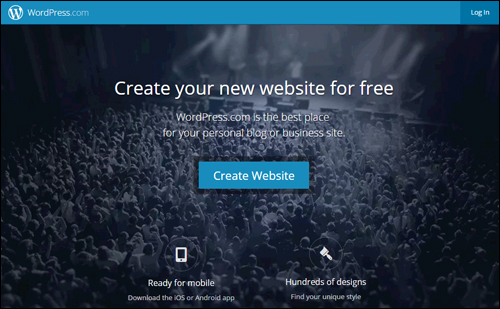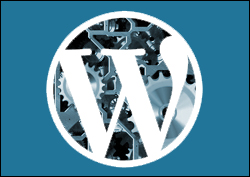
Welcome to Part 3 of our Website Traffic Blueprint article series, where we show you how to automate traffic to your website using the WordPress CMS.
In Part One of this article series, we provided an overview of the process, and explained why using an expertly configured WordPress site is the key to generating automated web traffic …
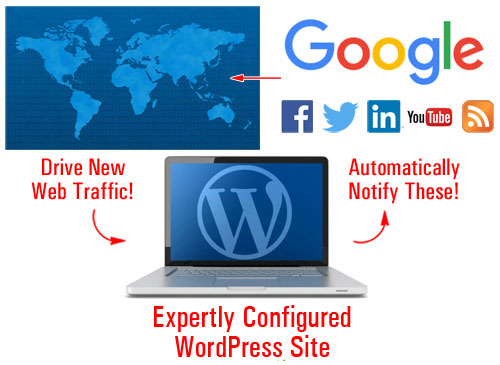
(With an expertly configured WordPress website or blog, all you have to do to start generating new traffic is publish fresh content regularly!)
In Part Two, we looked at the setup phase of the blueprint. We explained the best way to get started if you don’t have a web presence yet, how to set everything up if you already have a site, and what to do if your existing site has been built using WordPress.
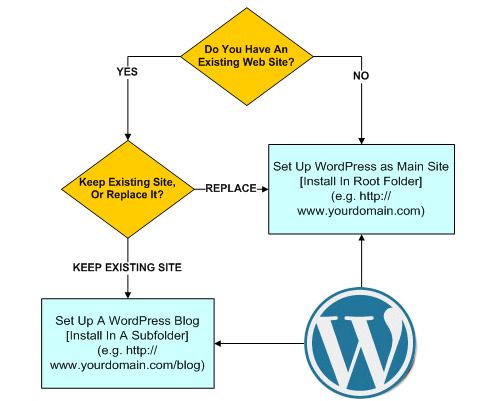
(In Part 2 we show you where to set up a WordPress website or blog on your domain)
In this section of the series, we will look at the configuration stage of the traffic blueprint. We will help you understand what makes an expertly configured WordPress site different. You will also understand how much work is required to make sure that when all is fully configured, you can automatically begin to get new traffic simply by posting fresh content to your site.
WordPress Web Traffic Blueprint – Configuration Phase
Finding ways to drive more traffic to one’s website is often cited by most website owners as their greatest challenge online. With competition making business survival progressively tougher businesses are looking for any advantage they believe will help them increase their competitiveness online.
Having the ability to generate traffic on demand is a tremendous competitive advantage. An expertly configured WordPress site gives you a flying start as soon as your site is launched.
The Difference Is In The Configuration
There is a difference between an expertly configured WordPress site and a website that has been professionally set up by an expert website developer but not necessarily configured to its fullest advantage.
Here’s one way to describe the difference:
An expertly configured WordPress site gives you a web presence and an automated online business marketing process!
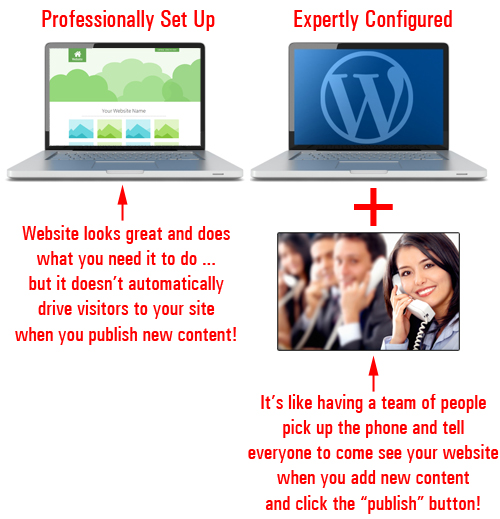
(An expertly configured site gives you a web presence and an automated online business marketing system!)
Not only is more work required to build and integrate an automated online business marketing system into your website, but also a special type of expertise.
Let’s illustrate this with a little story.
Are Experts Worth The Money They Charge?
Things were going well in the widget plant when suddenly, production stopped.
As no one could figure out what happened, the manager decided to call in an expert to try and fix the problem.
Promptly after arriving, the expert immediately went to the control box. After staring at the schematics for what seemed like 2 minutes or less, the expert then produced a teensy-weensy hammer and made a very gentle tap near the right side of the unit.
Immediately, everything inside the factory floor began to work again.
The manager was grateful and relieved as he thanked the expert, who left just as quickly as he had arrived.
A few days later, the factory manager received a request for payment of $5,000.
The manager picked up the phone and dialled the expert, demanding to know why they were expected to pay such a ludicrous fee for so little time spent delivering such a minimal amount of work. He then requested an itemized invoice before hanging up.
The next day, an invoice statement arrived in the manager’s in-tray. Upon opening the envelope, this is what he saw:
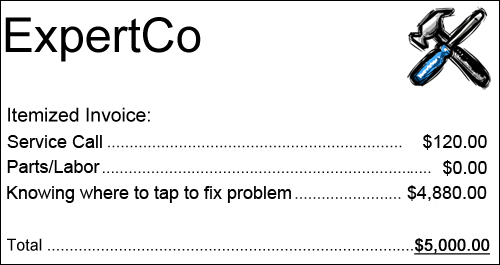
The main challenge most businesses face online is being able to consistently drive new visitors to their sites.
How much money did the gizmo plant stand to lose when the equipment stopped functioning and no one on the business was able to fix it? Did the expert in our story not have every right to get paid fairly for having invested years building up the knowledge, skills and expertise that allowed him to immediately avert a very serious crisis?
Similarly, if you could have a website or blog set up so all you have to do is publish new content and Google, Facebook, Twitter, LinkedIn, YouTube and dozens of other web properties would be automatically notified, how much time and money would this save you?
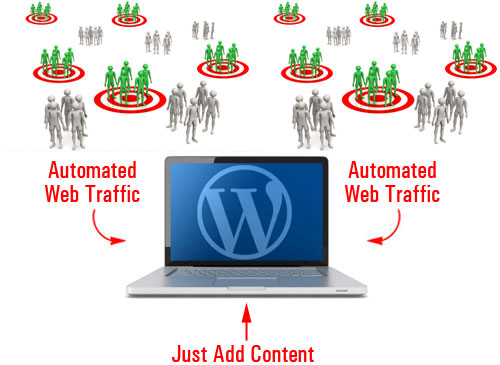
(How much better would your business be if you could automate the process of attracting new visitors to your site?)
While experts often make difficult things look easy, it rarely is that simple or easy.
Knowing how to expertly configure a WordPress site involves more than adding some pages with content and configuring a few settings. It involves knowing where to tap! In other words, knowing things like:
- Which plugins need to be installed to get certain functionalities on your site.
- Which 3rd-party accounts need to be set up to achieve specific outcomes
- Which options need to be configured to make sure processes will work as envisioned, etc.
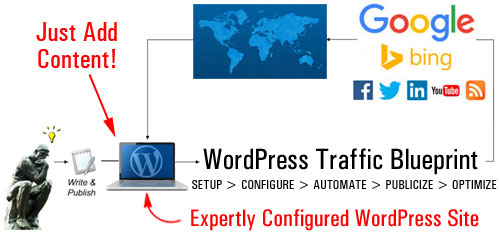
(Generating new traffic automatically with WordPress is a process that requires knowledge and expertise)
Although this stage of the WordPress traffic automation system may not seem so technically difficult, it can be quite involved and time-consuming. It’s not as easy as installing a piece of software, tweaking some settings in your dashboard area or clicking a couple of buttons … it’s all this and so much more.
Expertly configuring your website is a process that involves your web hosting server, your website, and a number of external sites and services …
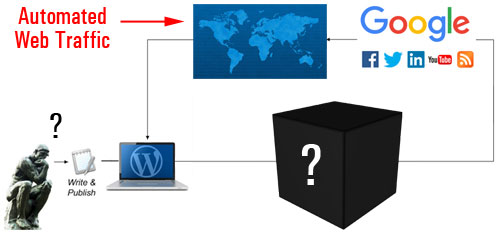
(Expertly configuring your website involves more than just configuring a few settings in WordPress)
If the configuration process were to be flowcharted, it would look something like this …
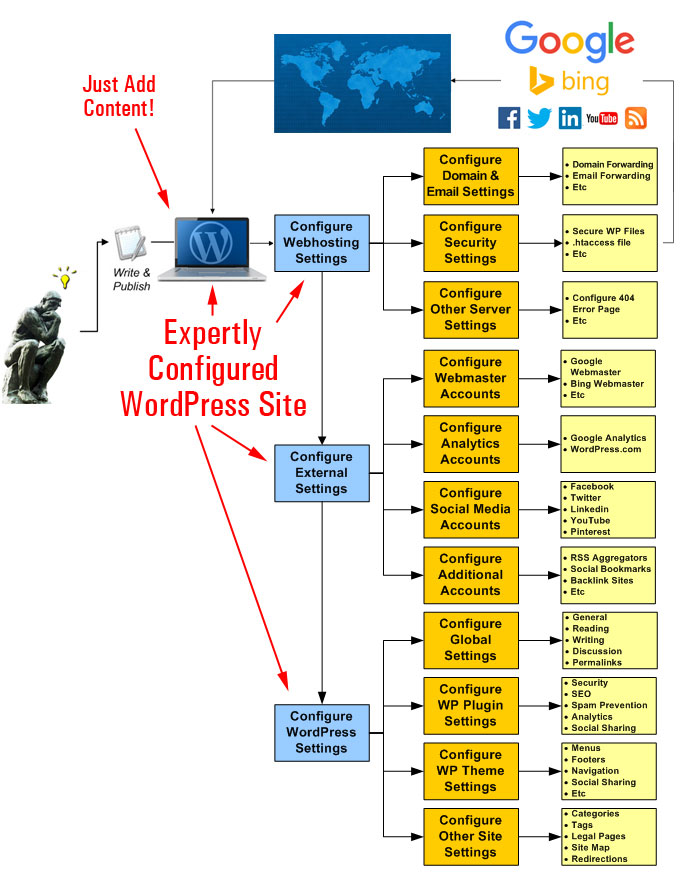
(A simplistic flowchart of the activities involved in the configuration process)
Let’s take a brief look at these areas.
Server Configuration
We’re not talking here about the process of configuring your web-hosting account for site installation purposes (this is normally done during the Setup phase). What we are talking about, is tweaking settings in your server that affect how your site will handle all web traffic …
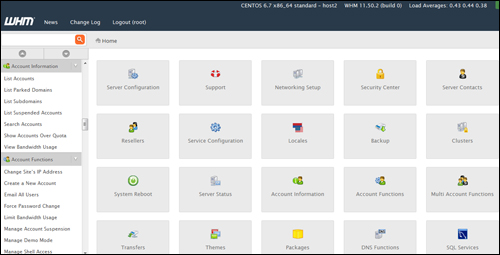
(In the configuration stage, your server settings need to be fine-tuned for handling both good and bad traffic)
Not all traffic is positive traffic. Some of the web traffic your website can attract will be unwanted traffic like spam, security threats, brute-force bot attacks, etc.
This aspect of the configuration process, therefore, requires evaluating your needs, planning for both good and unwanted traffic and adjusting settings in your server accordingly. This includes things like integrating server-level spam protection and securing server files, to configuring domain and email redirections, setting up error page redirections, etc …
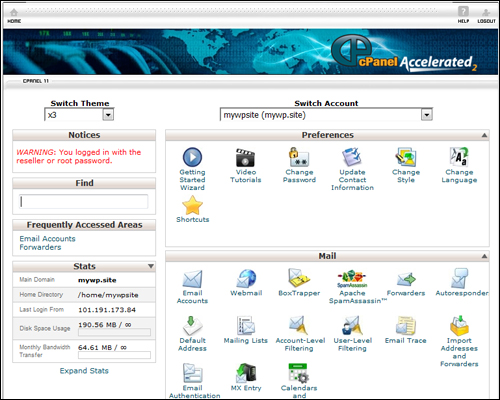
(Have you configured your control panel settings for handling things like emails, page errors, etc?)
Once your web server settings have been fine-tuned and configured, the next step of the configuration phase is to set up various external sites or online services.
External Sites
The basic concept of choosing external sites is that all of your content should be published from a central location (your WordPress site) and from there, get automatically distributed to other components of your traffic system, or notify traffic-related web properties and services.
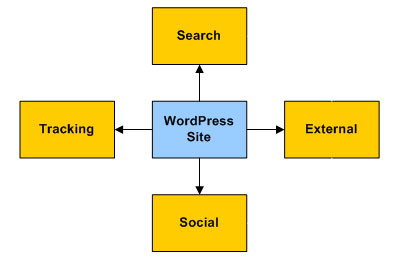
After incorporating these external services into your system, content with links pointing back to your site will get automatically syndicated to search, social and aggregator sites. Your content and site will then receive increased exposure online, helping you tap into new sources of traffic.
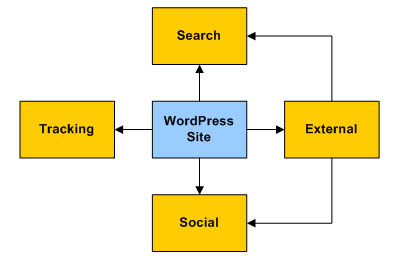
Some external web properties and online solutions will need to be set up before configuring your settings to help speed up the process and some will need to be done later, during the automation phase.
For example, you will want to set up the following accounts:
Google Webmasters
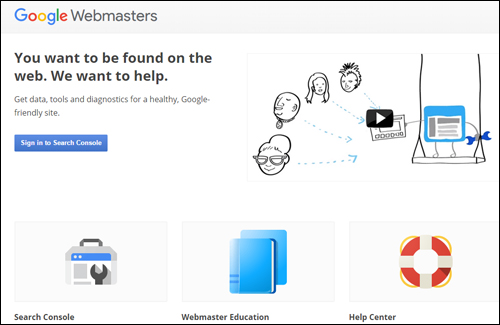
(Google Webmaster Tools)
Google Webmasters lets you tell Google about your site’s pages, submit XML sitemaps for faster page indexing, and provides you with important information, tools and reports about your website.
After setting up your account and entering site details, the details can be used with web traffic-related settings in WordPress and other applications.
Google Analytics
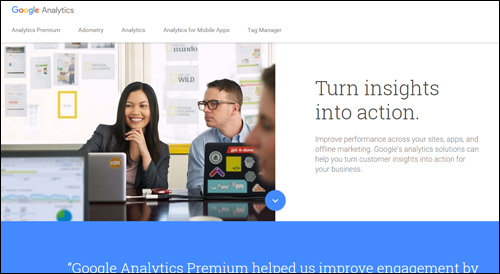
(Google Analytics)
Google Analytics lets you improve your website’s performance, SEO, marketing campaigns, and more, by tracking all user engagement, pages visited, keywords searched for, organic referrers, etc.
Once your Google Analytics account and site details have been set up, visitor tracking information can be added to WordPress using any of several Google Analytics plugins and automatically sent to many other useful applications.
Bing Data And Tools
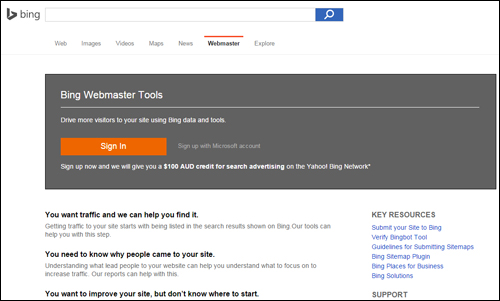
(Bing Webmaster Tools)
Bing Webmaster Tools is similar to Google Webmaster Tools. After setting up your account and entering site data with Bing Webmaster Tools, this information can be used to integrate and automate traffic settings in WordPress using plugins like Yoast SEO (see further below) and other applications.
WordPress.com
(WordPress.com)
As discussed in Part 2, WordPress offers the option of a hosted vs self-hosted website. We recommended choosing the self-hosted WordPress platform if you plan to build a professional business presence online.
WordPress.com (the hosted option), however, provides a number of useful tools, which a number of WordPress plugins can access. We recommend setting up an account at WordPress.com, therefore, and we’ll explain how to integrate these features into your traffic generation system in Part 4 of this article series.
Social Media And Social Bookmarking

(Syndicate your content automatically to your social media and social bookmarking accounts and get new visitors to your site)
You will need your social accounts set up before you can configure these as part of your traffic generation system.
Once you have set up and configured everything, you will be able to syndicate your content automatically to your social media sites and drive new traffic to your site.
You should have accounts and profile pages with all the popular social networks – Facebook, Twitter, YouTube, LinkedIn, Pinterest, etc.

There are many social bookmarking sites you can set up accounts with. You don’t need to create accounts with all of them, just choose those that will work with your setup and/or content syndication tools (we cover some of these tools in more detail during the Automation phase).
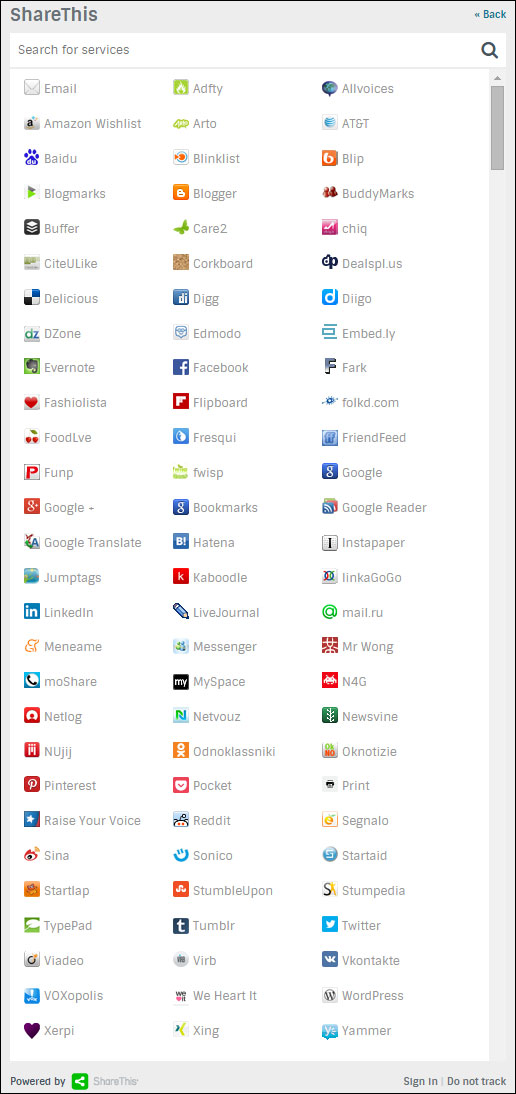
(You can syndicate your content to lots of social sites. Image: ShareThis.com)
Additional Solutions, Aggregators, Etc.
There are a number of online platforms and RSS aggregators that can serve as secondary traffic generation sources. Some are free or provide free levels, and some are more suitable for enterprise-level applications.
For example, here is a content aggregator that allows you to add your WordPress blog feed …
RebelMouse
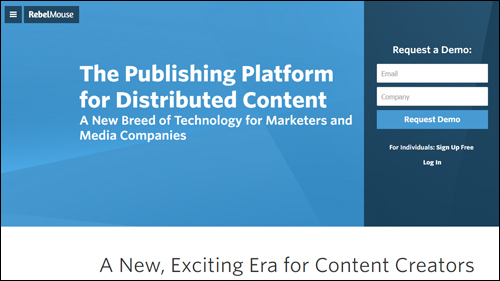
(RebelMouse)
RebelMouse is a news aggregator for your RSS feeds and social profiles. Your content is displayed in a Pinterest-like format and visitors can follow your website.
![]()
There are many different solutions that can be incorporated into your traffic system. Please feel free to contact us if you need assistance exploring some of these further, or to discuss a configuration plan to suit your needs.
After you have configured your web server and set up accounts with third-party sites, it’s time to configure your WordPress settings.
WordPress Site Configuration
The first step in configuring your site for traffic is to make sure that your global settings have been correctly set up.
Let’s go over some of the important areas.
Global Settings – WordPress
Your WordPress admin area contains a Settings menu that allows you to configure your site’s global settings …
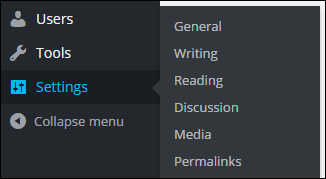
(WordPress dashboard menu – Settings)
General Settings
Sections like Site Title and Tagline can influence your site’s SEO, search indexing, etc …
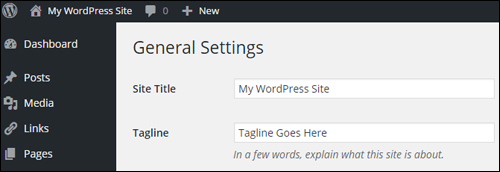
(Settings Menu – General Settings)
Writing
The Writing Settings section contains one of the most important and frequently overlooked built-in traffic notification systems available to WordPress site owners …
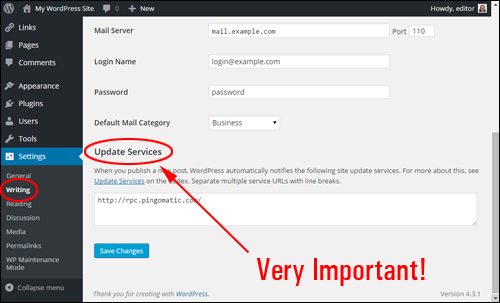
(WordPress Settings – Writing Settings Screen)
As described below the Update Services section title,
When you publish a new post, WordPress automatically notifies the following site update services …
Unless you or your webmaster have purposely configured your settings to prevent search engines from indexing your site, then your site will automatically notify the list of services entered into the Update Services field
With an ‘out of the box’ WordPress installation, only one service is listed …
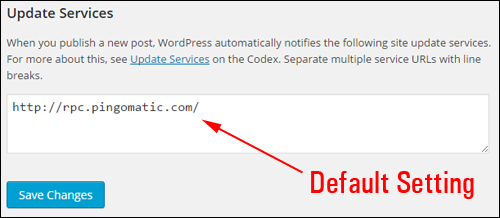
(Update Services)
You can notify dozens of update services automatically with WordPress – just add a list of all the update services you want to notify as soon as you publish a new post to this section …
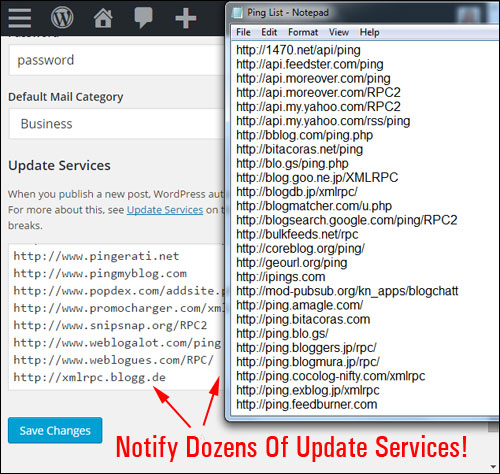
(WordPress lets you notify dozens of update services automatically!)
![]()
Download A Comprehensive List Of Ping Services For Your WordPress Site!
Click the link below to download a comprehensive list of reliable and authoritative ping services for your WordPress site or blog:
Download A List Of Ping Services For Your WordPress Site
***
Note: If you need help setting up the list of ping services on your site, we recommend using a professional web services provider. You can find professional WordPress service providers in our WordPress Services Directory.
Reading Settings
This section affects how your content gets seen by readers when they visit your home page and blog pages.
The syndication settings in this section can influence traffic. For example, choosing to display the full content vs summaries of your post, affects how your content appears in RSS feeds and RSS email campaigns, and could affect someone’s decision to explore your content further, and whether or not they will visit your website or blog to read the rest of the content from a partial feed, or read the content in full without the need to click through to your site.
The most important setting in this section as far as your traffic system is concerned is whether the Search Engine Visibility checkbox is enabled or not.
Generally, you want search engines to visit your site. Leaving the box unchecked allows your site to instantly notify various update services when a new post gets published (see Writing Settings above). Unless you have a specific reason to discourage search indexing spiders from visiting your site, do not check this box …
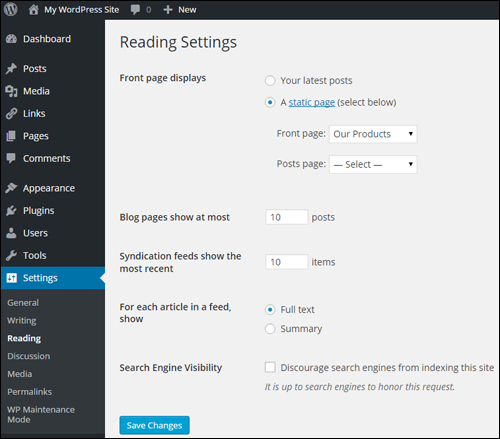
(Global Settings – Reading Settings)
Discussion Settings
Although this section is mostly concerned with how users engage with content on your site, you have the option to allow notifications to sites linked to from your posts, and to allow link notifications from other blogs (pingbacks and trackbacks). This can work for you, but it can also drive bad traffic in the form of SPAM comments …
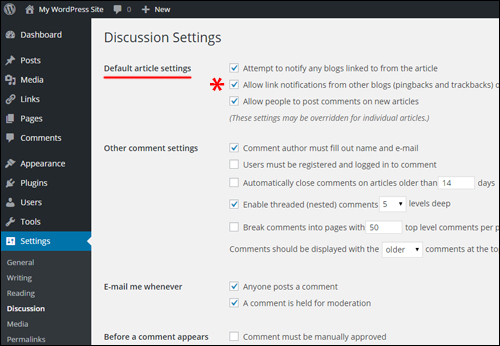
(Global Settings – Discussion Settings)
Permalinks
Your Permalink settings allow you to create SEO-friendly URLs …
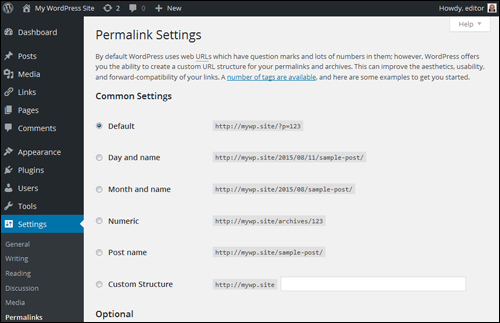
(Settings Menu – Permalinks)
Here are some of the options for configuring your permalink URLs …
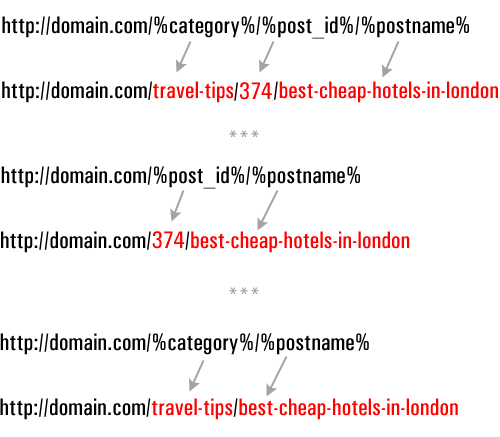
(Configuring SEO-friendly URLs)
We have created a detailed tutorial on using permalinks here: Using Permalinks To Improve Your WordPress SEO
WordPress Traffic Plugin Settings – Configuration
WordPress provides users with plugins that help to add just about every kind of functionality imaginable to your website, including many plugins that improve traffic generation.
Let’s look at examples of plugin categories and plugins that can help to attract more visitors to your site
Blog Defender Security Plugin
Once again, it’s important to configure your site for handling both good traffic and bad traffic. No website is immune from being hacked.
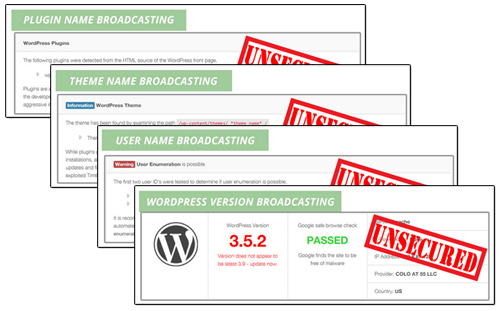 (WordPress Security Plugins stop bad traffic from causing your website harm)
(WordPress Security Plugins stop bad traffic from causing your website harm)
Security plugins like Blog Defender help to make your blog invisible to hackers and bots.
For more details, go here:
WordPress SEO Plugins – Yoast SEO
WordPress SEO plugins help drive traffic by making your site more search engine friendly …

(Yoast SEO – WordPress SEO Plugin)
A plugin like Yoast SEO (previously called WordPress SEO by Yoast) can improve your site’s SEO. Once properly configured, this plugin not only makes your web pages easier for search engines like Google and Bing to find, crawl and index, it also lets you specify how your content will show up in Google’s search results and social media pages, e.g. Facebook, Twitter, and GooglePlus.
Social Sharing Plugins
Allowing your visitors to share your content online can help boost traffic to your site, especially if your site provides great content that adds value to readers.

(WordPress users can easily add social sharing to their site with WordPress plugins)
You can easily add social sharing features to your site with free or inexpensive plugins.
Most social plugins allow you to choose which social sites visitors can share your content to, embed social buttons into your content, set up default notifications, display/hide share counters (e.g. number of followers), etc. Some social plugins even allow you to set up protected content sections on your site which users can unlock by liking your page.
Theme Settings
As well as configuring various plugins, many WordPress themes also include features that can help you drive more traffic to your site.
For example, as well as options and settings for configuring the design and layout of your website, some themes also include built-in options for improving SEO and site linking structure for better indexing, add analytics snippets, social sharing buttons, etc …
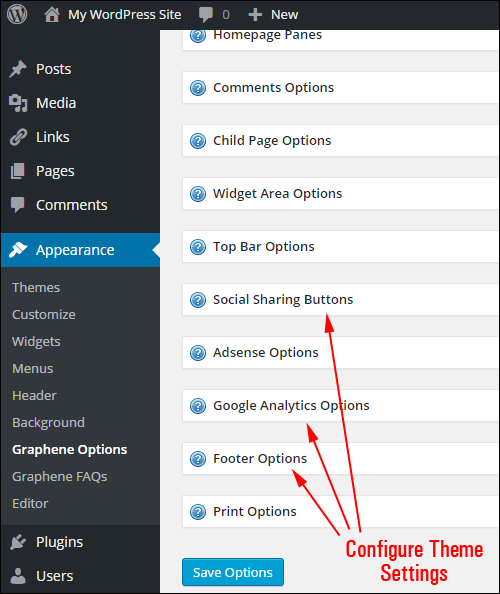
(Many themes like Graphene (a free theme) come with built-in traffic optimization features)
With many quality themes, adding social sharing features to your pages is as easy as clicking a couple of buttons and enabling the feature …

(Many WordPress themes have built-in social sharing features)
WordPress Traffic Configuration – Other Steps
Last but not least in the traffic configuration process, are the components that need to be set up outside of the global settings.
This includes:
Website Compliance Pages
Once again, when preparing your site for an increase in visitor numbers, it’s important to plan not only how to handle bad and good traffic but also for all the situations that can damage your business when more and more people begin to visit your website.
If you are making money online (or are planning to), you need to ensure that your website remains compliant with regulatory agencies.
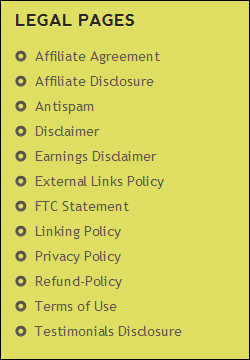 (Does Your Site Comply With All Legal Requirements?)
(Does Your Site Comply With All Legal Requirements?)
If you need help adding legal pages to WordPress, see this article:
Post Categories And Tags
Post categories and tags help search engines index your pages, which helps you get more traffic.
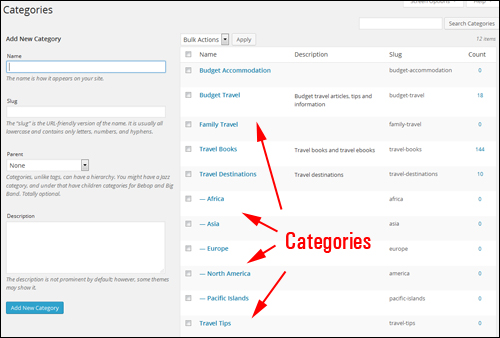
(Categories help search engines better organize and index your website, which helps to increase traffic.)
As we recommend in this article, it’s best to set up your site’s post tags and post categories earlier on, during the Website Planning Stage.
When considering ways to automate and improve traffic, you will want to review and make sure that your site’s categories and tags have been correctly set up to deliver optimal benefits.
A Site Map Of Your Posts And Pages
A visitor site map that lists all of your posts and pages is not only a useful navigation tool, it can also help external sites find more of your online content …
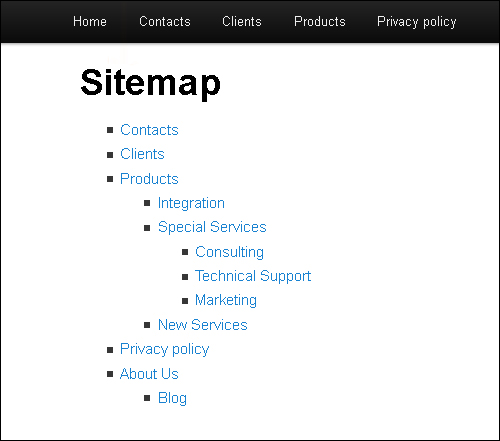
(Site Map – great for visitors and beneficial for web traffic too!)
![]()
An HTML site map and an XML sitemap are two different things. Although search engines like Google can index your pages just from an XML sitemap (which plugins like Yoast SEO can provide – see earlier section), making it easier for visitors to find more pages on your site can result in increased traffic.
404 Error Page – An Additional Source Of Traffic!
When visitors searching for your site type in the wrong web address or click on hyperlinks pointing to pages on your site that no longer exist, they are greeted with an error page …
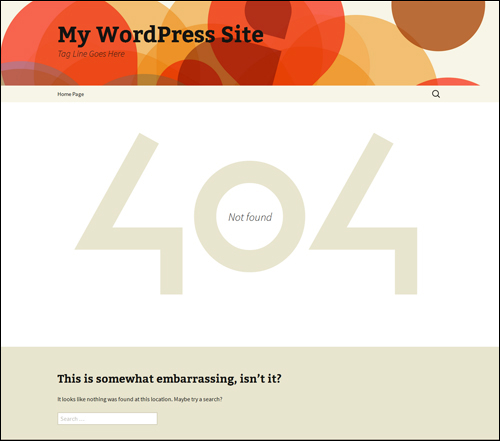
(Default WordPress 404 Error Page)
A 404 Not Found page can redirect confused visitors to your functional pages …
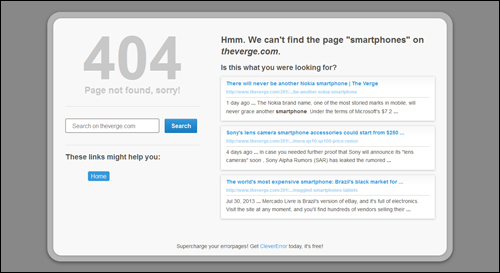
(Configuring your 404 page allows you to recover traffic that may otherwise be lost.)
![]()
Although a 404 Not Found error page can be set up in your web server, there are several WordPress plugins that allow you to easily configure your 404 page inside your WordPress admin.
WordPress Traffic Automation System: Configuration Process – Summary
Once you have your WordPress site fully set up and expertly configured, all you need to do to automatically begin bringing traffic is add great content on a consistent basis.
The process of expertly configuring your WordPress site, however, can be quite involved and elaborate and requires the configuration and integration of different components and web properties …
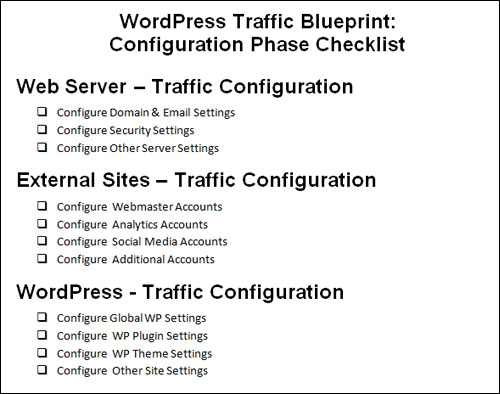
(WordPress Traffic System – Configuration Checklist)
![]()
The kind of skills and expertise required to perform the configuration process can take many web developers a long time to learn.
Once you have expertly configured your WordPress site, the next step is to automate the process. This step is explained in the next article in our series.
This is the end of Part 3
To read more, click on the link below:

![]()
This tutorial is part of an tutorial series designed to help you learn how to grow your business online using a WordPress-driven website and proven online marketing methods.
Subscribe Using The Form Below And Get Notified Of New Tutorials!
***
"Learning WordPress has been a huge stumbling block for me. I've been looking for something that covers absolutely everything but doesn't cost an arm and a leg. Thank you so much ... you have just provided me with what I have been looking for! Truly appreciated!" - Tanya
***
